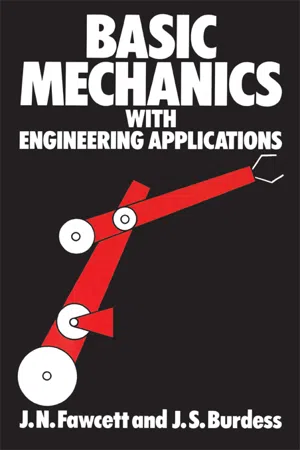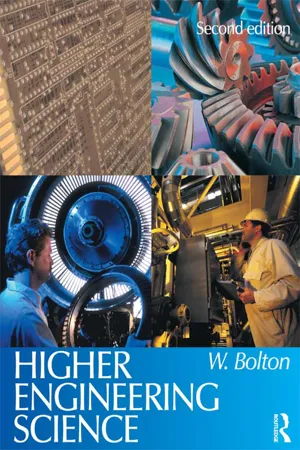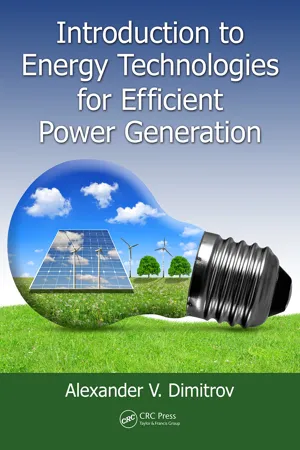Physics
Mechanical Power
Mechanical power refers to the rate at which work is done or energy is transferred in a mechanical system. It is the product of force and velocity, representing the amount of work done per unit of time. In physics, mechanical power is measured in watts and is a fundamental concept in understanding the performance of machines and mechanical systems.
Written by Perlego with AI-assistance
Related key terms
Related key terms
1 of 4
Related key terms
1 of 3
3 Key excerpts on "Mechanical Power"
- eBook - ePub
- J Jones, J Burdess, J Fawcett(Authors)
- 2012(Publication Date)
- Routledge(Publisher)
power of the system which is applying the force. For example, the power of an engine is the rate at which the engine can do work on another system.The units of power are Js−1 , Nms−1 or in fundamental units, kgm2 s−3 . Power is often quoted in Watts (W) so that 1W = 1 Js−1 = 1 Nms−1 = 1 kgm2 s−3 .Using eqn (5.21) power may also be expressed asThe term δr/δt is the magnitude of the velocity vector ν of the point of application of the force.in which θ can be interpreted as the angle between the force vector F and the velocity vector ν of the point of application of the force, as shown in Fig. 5.16 .FIG . 5.16When F and ν are given in terms of their components Fx , Fy and νx , νy eqn (5.3) shows that the power P can also be written in the formSimilarly if the point of application of the force moves with ν = ds/dt along a curve C as shown in Fig. 5.17 then eqn (5.8) gives the power P asFIG . 5.17The power is therefore determined by the tangential component of the force Ft , and the velocity ν of the point of application of the force along its curve.From example 5.2 the work δW done by a moment, or torque, M can be written asThe rate at which work is done by the moment is thereforeFor example, in a case where the moment M is applied to the end of a shaft, will be the angular velocity of the shaft.Example 5.4 Figure 5.18(a) shows the torque characteristic of a motor in which the torque M varies with its rotational speed ω such thatLet us find how the power output of the motor varies with speed. From eqn (5.27)FIG . 5.18The speed at which maximum power is developed can be obtained by differentiating eqn (ii) with respect to ω and equating the result to zero, i.e.Thus, at maximum power,The graph of P against ω is as shown in Fig. 5.18(b) .When a motor with such a torque characteristic is used to drive a steady load, the size of the motor can be minimised by ensuring that the motor runs at a speed of ω0 /2 i.e. at its maximum power condition. If the required steady angular velocity ωL of the load is different from ω0 /2 it would be desirable to connect the motor and load together via a gearbox with speed ratio ω0 /2:ωL - eBook - ePub
- William Bolton(Author)
- 2012(Publication Date)
- Routledge(Publisher)
5 Energy transfer5.1 IntroductionThis chapter is concerned with the energy transfers that can occur with mechanical systems. Energy can be transferred from one form to another by work being done or by heat transfer. Here we restrict the discussion to transfers involving work. There are many forms that energy can take and in this chapter potential energy, linear and angular kinetic energy and strain energy are discussed and the principles applied to the solution of mechanical system problems.5.1.1 Conservation of energyThere is a basic principle that is used in all discussions of energy and that is that energy is never lost, it is only transformed from one form to another or transferred from one object to another. This is the principle of the conservation of energy. In any process we never increase the total amount of energy, all we do is transform it from one form to another.5.2 WorkThe principle of the conservation of energy is that energy is never created or lost but only converted from one form to another. In all such conversions, the total amount of energy remains constant.Work is said to be done when the energy transfer takes place as a result of a force pushing something through a distance (Figure 5.1 ), the amount of energy transferred W being the product of the force F and the displacement s of the point of application of the force in the direction of the force.Figure 5.1 WorkWith force in newtons and distance in metres, the unit of work is the joule (J) with 1 J being 1 N m.Work done by a constant force W = Fs [1] Consider the work done by a force F when the resulting displacement s is at some angle 0 to the force (Figure 5.2 ). We can look at this in two equivalent ways. We can consider the displacement in the direction of the force F is s cos θ and so the work done is:work done = F × s cos θ [2] Figure 5.2 An oblique forceAlternatively, we can consider the force component acting in the direction of the displacement. The force can be resolved into two components, namely F cos θ in the direction of the displacement and F sin θ at right angles to it. There is no displacement in the direction of the F sin θ component and so it does no work. Hence the work done by the oblique force is solely due to the F cos θ - Alexander V. Dimitrov(Author)
- 2017(Publication Date)
- CRC Press(Publisher)
2Conversion of Thermal Energy into Mechanical Work (Thermal Engines)Energy-related (power) technologies may be treated as a combination of engineering-technical methods of energy and work conversion employed to facilitate human life. They are divided into two main groups. The first group comprises technologies of heat conversion into another type of energy (mechanical, electrical, electromagnetic, etc.) while the second one comprises technologies of heat transfer, accumulation, and regeneration. Each thermal technology discussed herein will be illustrated by specific physical schemes and devices. We shall consider them in the following order:•Technologies of mechanical work performance (so called thermomechanical technologies) •Technologies of generation of electrical energy (thermoelectric technologies) •Technologies of heat transformation (regeneration and recuperation) •Technologies of heat transfer and collection (transfer and accumulation) •Technologies creating comfortable environment (air conditioning and ventilation)Thus, we will treat a certain technology as an object of study of respective scientific-applied research fields, on one hand, and we will follow the teaching programs on “Power engineering,” “Transport management” and “General mechanical engineering,” on the other hand.2.1 Evolution of Engine TechnologiesAs is known from physics, energy conversion follows a natural course, that is, energy of motion of macro- and microbodies (popular as mechanical energy) is converted into heat by mechanisms that are studied by tribology (including dry, semi-dry, viscous, or turbulent friction). No opposite transformation is observed in nature. Heat conversion into energy needed for the operation of machines and mechanisms was an impossible task for primitive people as well as for those living in slave-holding* and feudal†
Index pages curate the most relevant extracts from our library of academic textbooks. They’ve been created using an in-house natural language model (NLM), each adding context and meaning to key research topics.
Explore more topic indexes
Explore more topic indexes
1 of 6
Explore more topic indexes
1 of 4


